


Though rather dilapidated Lima is not without interest - especially the great pyramid complex at Huaca Pucllana.
Cuzco was known as the navel of the Inca world. High in the Andes it has a fascinating mix of Spanish colonial buildings and Inca remains.

Our guide and driver met us at the airport and suggested we go tour the city straight away as it was too early to check into our hotel. Fortunately, though we'd flown via Sao Paolo and it was a long flight from Europe (12 hours first leg, 5 hours second) we were lucky enough to be travelling business class so weren't feeling too bad.

Though Lima is principally a Spanish colonial city, rather dilapidated these days, it has evidence of pre-Inca civilisation. Huaca Pucllana is an adobe site dating from the fifth to the eighth century AD. It was an important administrative centre for the Lima culture which developed from 200AD on the Peruvian coast in this region.


The great pyramid is an impressive structure, 500 meters long and 22 metres high, accessed by ramps and stairways to its different levels. The adobe bricks were laid on end, each long vertical side being about 25cm, in an unusual way of building up the structures - it doesn't look inherently very stable. The whole site is believed to have had a ceremonial as well as an administrative function.
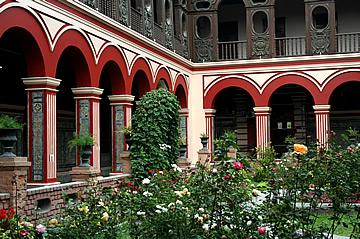
Lima was, for us, a departure point for visiting the Inca remains in the interior of the country, but we found it had one or two fascinating sites in amongst the rather decayed historic centre.


Our guide was very keen to show us the beautiful buildings of his city, many of which are sadly in a very poor state of repair. The city suffered a huge earthquake in 1745 but some of the oldest buildings have survived.


The sixteenth century church and convent of Santo Domingo is a complete contrast to almost everything else we saw in Lima. Close to the Rimac River on Jirón Camaná it was started soon after Lima was founded. Its peaceful cloisters are lined with paintings and hand painted Spanish ceramic tiles.

Santo Domingo is also the site of the tombs of Santa Rosa of Lima and San Martin de Porres, one of Peru's most revered saints. It has the most magnificent library with over 25000 books. Cedar wood is used throughout the buildings, from a beautifully carved ceiling to choir stalls.


Plaza de Armas lies at the north east end of Jr. de la Union, a large spacious square where people gather in the pleasant gardens surrounded by imposing buildings: the cathedral, rebuilt after the earthquake, next to it the Archbishop's Palace, rebuilt in 1924, with beautiful wooden balconies, and the yellow-walled Governor's Palace which stands on the site of the original palace built by Pizarro.

We walked Jirón de la Union, built on the orders of Francisco Pizarro in 1535, the year of the foundation of Lima. It was once the most aristocratic of streets in the city but now its ornate facades mostly front dilapidated buildings unoccupied above the ground floor. Large commercial companies have moved away from the historic centre to the newer parts of Lima. Some effort is being made to use the old buildings, for instance a beautiful old bank had become a huge shoe shop.

Enclosed glass balconies, very reminiscent of Spanish coastal cities such as Cadiz, can be seen in side streets, most in a terrible state. Dating mostly from the colonial period the city is making some effort to preserve them.




The church of San Francisco, north of Plaza de Armas and close to the river, was finished in 1674 and survived the 1745 earthquake. We particularly wanted to visit this one because of the celebrated catacombs: huge stone vats in a labyrinth of underground rooms, filled with bones slowly decaying. Mostly they are the tough leg, arm and pelvic bones, but also heaps of skulls - very creepy. Our guide thought there may be the bones of over 20,000 bodies here, though there are no more interments. An interment ceremony usually involved a short service at a chapel of the deceased's patron saint within the church, then the body was tipped down a chute or steps nearby.
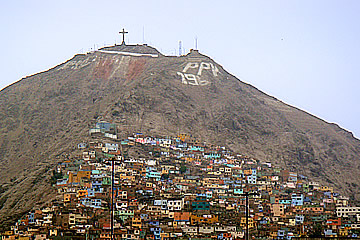
Across the river to the north the multi-coloured shanties climb San Cristobal mountain in the Rimac district. Like many developing countries the rural poor flock to the cities and Lima's population has exploded through the twentieth century.




In huge contrast, Casa de Osambela on Conde de Superunda is one of the largest and grandest colonial mansions, and is one of the better preserved, with five beautiful wooden and glass balconies and a tower.

To add to the mix of architecture a fine Art Deco building now houses a Macdonalds - at least it is in a great state of repair! Jr. de la Union could really be made into an architectural display case if money could be found to restore the wide variety of buildings.
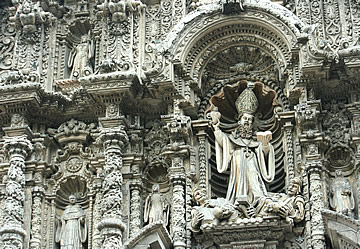
Continuing along Jr. de la Union, the 18th century churches of San Agustin and La Merced are good examples of Spanish baroque or churrigueresque architecture. The Church of La Merced can be seen on one side of the Plazuela de la Merced. The church stands on the site where the first Mass was said in Lima and where, subsequently, its first church was built.
Plaza San Martin at the south western end of Jr. de la Union was entirely created in the early twentieth century to mark 100 years of independence from Spain in 1921. The central equestrian statue is of José Francisco de San Martin, an Argentinean general and one of the prime movers, together with Venezuelan Simón Bolivar, in South America's struggle for independence from Spain. On 12 July 1821, after seizing partial control of Lima, San Martín was appointed Protector of Peru and Peruvian independence was officially declared on 28 July. Bolivar later took over the task of completing the liberation of Peru. The grand, if rather dilapidated, buildings surrounding the square are mostly unoccupied above the ground floor, something which is quite common in the historic centre. The taxi drivers circle the square, calling out their destinations, only leaving once they have a full car.

We were staying at the Casa Andina Private Collection Hotel in the Miraflores district, not far from Huaca Pucllana. There is a restaurant at the ruins where we had dinner, taking the hotel car and arranging for it to pick us up later. The ruins are floodlit and a very atmospheric backdrop to our table on the terrace. We had our first pisco sours this evening, a fabulous drink of pisco (a grape brandy), lime juice, syrup, egg white and bitters - much stronger than I'd anticipated! The food was excellent and we tried a couple of Peruvian specialties: guinea pig "chicharron" - a slightly sweet meat with an excellent criolla (creole) sauce, and lomo saltado was strips of tenderloin done with chile, peppers, onions and tomatoes.


The following morning we flew from Lima to Cuzco. The flight was about 75 minutes - a short time to ascend around 3400m and we both immediately felt the effects of altitude, though in Switzerland we have gone higher than this and never suffered at all.
After collecting our luggage we were met by our guide and driver who took us straight to our hotel, the Libertador. This is a beautiful place, it even has original Inca walls, the foundations of Francisco Pizarro's palace.


We dropped our things off and went out for a look around and some lunch. Around the corner from the hotel is San Agustin, a street of beautiful blue and white colonial houses, with Inca wall foundations. Most notable is the Casa de los Cuatro Bustos which belonged to a Spanish noble family.

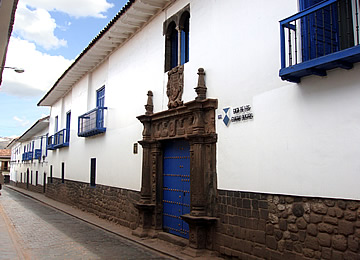

Cuzco was founded in the eleventh century as the centre of the vast Inca empire. Prior to this point the civilisation of this part of South America was based on tightly knit autonomous small communities. The genius of the Incas was to bind these communities together into one state and rule it from Cuzco. They were sun worshippers and their greatest king was the fifteenth century Pachacuti who imposed Quecha as the common language, thus further binding the people together. Spaniards began arriving in the city in 1533. They destroyed many Inca buildings, replacing them with their own, often incorporating the Inca walls.


Though the sun was shining Cuzco was much colder than I was expecting. We walked to the centre of the city, Plaza de Armas, which has several places to eat.
Plaza de Armas was originally the Inca Huacaypata - the place of tears. We passed lots of wonderful Inca walls, mostly in the lower levels of buildings, all angled inwards. We were immediately struck by how perfect they are. They are very strong, surviving many earthquakes that have destroyed colonial and more modern buildings.
We ate at the Inka Grill on the north side of Plaza de Armas with a great view of the square from our first floor table and local musicians playing. After the meal I again began to feel the effects of the altitude - probably all my body's energy reserves were now employed digesting the food! - so we returned to the hotel to rest.
The following day our guide came to take us around Cuzco. We started in Santo Domingo which is right next door to the Libertador.
The 17th century church and convent of Santo Domingo were built on the foundations and walls of the ancient Inca Sun Temple or Qorikancha. Qorikancha was the centre of Inca Cuzco - itself the "navel" of the Inca world.
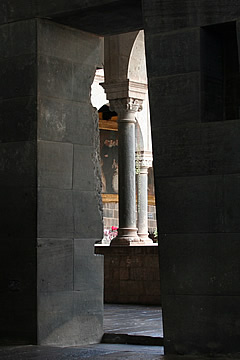

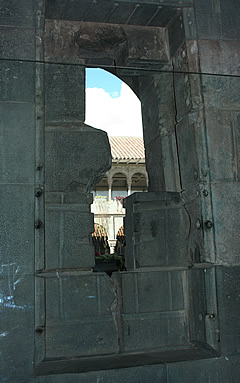

The typical Spanish cloistered convent stands on a wealth of Inca remains. There are several chambers with substantial angled walls and trapezoid windows and entrances.



There is a collection of stone blocks with grooves and hollows - perhaps clues to how the blocks were fitted together. The walls are just unbelievable, perfectly joined, with not a hair's breadth of space between the blocks. Many have small lumps on the surface which no-one seems to know the purpose of.
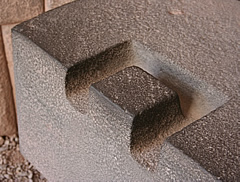
Apparently Qorikancha was filled with gold, from life size statues to huge gold plates lining the walls - what a sight it must have been. The Spaniards looted the lot and melted it down.
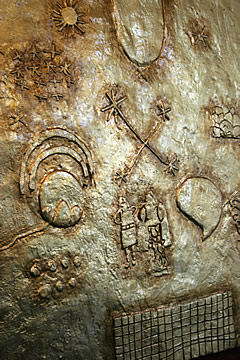
The only gold to be seen is a reproduction of an early seventeenth century gold panel illustrating the cults of the Temple of Qorikancha, though it was made many years after the cults had been expelled so may not be accurate. Nevertheless it is an interesting piece, the cults being associated with cosmological and meteorological phenomena.


A Qorikancha website helped with one or two of the more obscure symbols on the panel: a representation of the all-powerful creator Viracocha Pacha Yachachi as an oval disc, left and right the Sun Inti and Moon Qilla (both out of shot) and below these the Morning Star and Evening Star (Venus) respectively, below the Morning Star a number of stars represents the Pleiedes representing the time of summer, and the cross with four stars looks like the southern cross; far right are clouds representing the time of winter; the round disc represents Mother Earth or Pachamama, crowned with a rainbow (or arc of the sky?) and engraved with mountains and a river; the comma shape represents Mama Cocha, the goddess of the sea; in the centre are a man and a woman; the seven small discs represent seeds, from which all life is created, and just out of shot on the right is a tree representing ancestors and the revered jaguar; the grid represents the agricultural fields or crop terraces of the Incas - essential for life.
After this fascinating visit our guide walked us through the lovely streets of Cuzco to the cathedral - everywhere there is evidence of the Inca past.


The cathedral was built on the site of the Palace of Viracocha and because Incas were the labour and craftsmen used in its construction, they managed to include a lot of their own culture and religion into the painting and statues. There are many "Mary Virgins" (as Mel beautifully translated) with elaborate cloaks shaped like mountains - the traditional protectors of the Inca people. There are recognisably Inca features to the faces - even the Mary Virgins and Jesus in some cases. One of the disciples in a painting of the Last Supper - complete with guinea pig - looks like Pizarro! There are also incredibly magnificent altars using tons of gold, and the particularly fabulous main altar of silver with a small forest of silver columns.



On the northern outskirts of Cuzco lie the remains of this extensive ceremonial site still under investigation. It was long thought to be a fortress due to its massive walls and strategic location on high ground overlooking the city. In 1556 it played an important role in the battle for Cusco when the Emperor Manco Inca led his forces in rebellion.
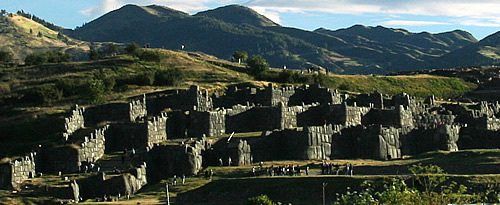
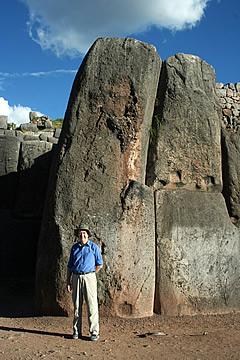
In all probability it was actually a sanctuary and Temple of the Sun. Storehouses have also been identified, the equivalent of our modern banks, holding the Inca's wealth of grain and produce - it would have been sensible, and entirely consistent with other sites, to locate them in a protective environment.


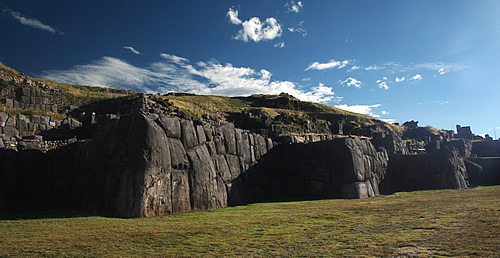

There are also the remains of three towers on the top of the hill, that at the higher point had three concentric walls. The number three was very important to the Incas, representing (among other things) heaven, earth and the underworld.

The hill on which these stand overlooks Cusco and on the northern side is protected by three long stretches of zig-zag walls fronting a massive plaza which could have held thousands of people. Perhaps sacrificial ceremonies were held at the temple in sight of the crowds below.
The protective walls, about 6m high, were built with huge boulders, weighing up to 130 tons but still fitted together with amazing precision - no mortar was used. The Spaniards destroyed much of the site, reusing the stones in their building works in Cuzco.


On the road to Pisac is this military outpost. Known as the red fort (pukara means fort), because of the colour of the walls, it is certainly in a good strategic position, but other theories are that it was a tambo - a resting place for travellers, or a lodge for dignitaries, perhaps even the emperor and his family, maybe when they visited the sacred springs at nearby Tambo Machay.


About 4km outside Pisac is the Temple of Qenqo. The name comes from a Quechua word meaning labyrinth - the Quecha were the people of this Andean region.


It is well-named - the mass of stone on the hillside hides a maze of tunnels and chambers. This is a temple of worship and sacrifice with an amphitheatre, probably used for public ceremonies.


The Intihuatana area is thought to be an astronomical study site, perhaps for time-keeping and prediction of important solar events such as equinoxes. Intihuatana translates roughly as "hitching post of the sun" and is a common feature of Inca ceremonial sites.
There are hollows, channels, carved thrones and steps, though outside many of the features are badly damaged.
Within a huge hollowed-out rock stands a sacrificial altar. Mel told us that in the pit behind it many bones were discovered: 80% animal, 20% human.
Gruesome but a fascinating place.
